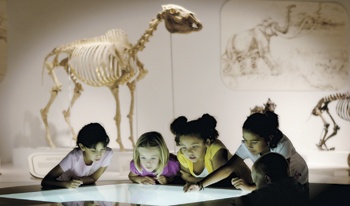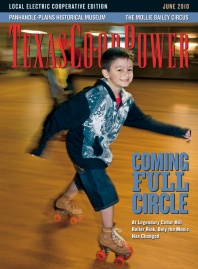Deep within the bowels of the Panhandle-Plains Historical Museum in Canyon, Jeff Indeck is rummaging through steel cabinet drawers like he’s looking for lost treasure. “Hold this,” the museum’s chief curator says casually, handing me the clavicle of a metoposaur, a 6-foot-long salamander-like amphibian.
The bone weighs only about 3 pounds, but its age—hmmm, a mere 225 million years old or so—makes it feel like a heavy chunk of priceless, breakable gold. Don’t even THINK about dropping it.
And so I gingerly hand it back to Indeck, who’s grinning with the unbridled glee of a kid just granted permission to grab a shovel and start an archaeological dig in his own backyard.
Indeck, whose full title is curator of archeology, paleontology, ethnology, geology and biology, clearly digs his job, especially when he’s playing detective in the basement where every sealed plastic bag holds yet another clue to the past.
Judging by their stuff—bits of yucca sandals, grinding stones and bison bone farming tools—this area’s early inhabitants were a lot like us: innovative and constantly finding new ways to improve their everyday existence. And just like us—someday, archaeologists might be poring through our heaps of athletic shoes, cell phones and computers—they couldn’t take their stuff with them.
Indeck holds up a bag of knotted yucca fibers that served an unknown purpose. “This is their trash,” he says. “What I’m interested in is what the objects they left behind tell me of their behavior.” Indeck then lays a piece of alibates flint on my notebook. Smooth on the bottom with an edged top, it probably was used as an animal hide scraper.
Researchers from around the world visit Canyon, 15 miles south of Amarillo, to study such specimens. From mammoth teeth that are just that to giant tortoise shells millions of years old, the basement’s riches form a rock-solid foundation for the museum’s public exhibits, where visitors explore 500 million years of history recorded across the 26,000-square-mile expanse of the Panhandle Plains.
Be forewarned: Once you enter Texas’ largest history museum, even with trusty map in hand, you’re going to get lost—deliciously lost as you stare into the eyes of a mounted bison in Pioneer Hall, the voluminous room that once held the entire museum, and wander through 22 galleries in the nearly 300,000-square-foot building on the West Texas A&M University campus.
It may feel like you’re actually covering 26,000 square miles, so the best advice is this: Pace yourself. Wear comfortable shoes. Don’t try to see everything in two to three hours. Schedule a day—or two—to fully appreciate this museum that boasts a collection of more than 2 million artifacts, including a world-class paleontology section and the most comprehensive collection of historic Texas art in the state. The collection features “Red Landscape,” one of four oil paintings that Georgia O’Keeffe completed when she lived in Canyon from 1916 to 1918 and taught art at what was then West Texas State Normal School.
Inspired by O’Keeffe’s trips to nearby Palo Duro Canyon, “Red Landscape” provocatively captures the magnificent geologic formation with blood-red brush strokes and the sensuous curve of canyon and sky. It’s a bold statement of not only what O’Keeffe saw, but what she felt—and it’s the perfect palette from which to draw conclusions about our total museum experience: From the pastels of Frank Reaugh—so gently nuanced you’ll feel like you’re sitting in the saddle beside the “Dean of Texas Painters” who often sketched from horseback—to the reconstructed bones of scary-looking prehistoric creatures, we don’t just see the past. We feel it. Especially when we think about the monstrous teeth of a phytosaur, a crocodile look-alike that could reach 40 feet in length, crunching down on its prey.
And it’s at that juncture, when we see the past as others saw it, that we gain empathy for our fellows, says Guy C. Vanderpool, the museum’s executive director and president of the Texas Association of Museums. “We hear the stories of people who have gone before us,” he says. “We see their photographs, we see their tools. So when we step back into contemporary society, it’s easier for us to identify with the struggles and achievements of people in our own communities.”
Sometimes, the past isn’t easy to look at, such as a life-size diorama and video in the People of the Plains exhibit that graphically detail the skinning and butchering of a buffalo. In the video—squeamish alert … this is the real thing—a Comanche man and woman methodically dissect the animal, with nothing going to waste: The stomach can function as a water carrier, and the buffalo’s liver is eaten raw to ensure more successful hunts.
Nowadays, we scrape food off our plates into the garbage disposal. Burp.
But as we digest the past, and something primitive stirs deep within, we realize that we have much in common with those we thought were so different. They needed food, water, shelter and clothing. So do we. Hence the chronological display of water vessels—prehistoric vase, canvas bag, metal bucket with dipper, plastic bottle—in People of the Plains.
“It’s an exhibit that looks at people as people,” Indeck says, explaining his philosophy: The degree of success is whether something—a tool, a practice, an idea—is passed on to the next generation. “Cultures are not hierarchal,” he says. “They’re not better or worse in their solutions to problems—they’re just different.”
Millions of years ago, there was a clear pecking order: The biggest, meanest predator won, such as the phytosaur, whose head is displayed in what Indeck calls a “truly spectacular” fossil collection. As Indeck explains, it’s rare to excavate intact skeletons. But incredibly, of the collection’s 10 mounted skeletons, two—a large fish called a wolf herring (Gillicus arcuatus) and a fish-like reptile (Ichthyosaurus)—were found in the ground virtually intact, with bones in their correct anatomical positions. And the skeleton of an extinct Scott’s horse (Equus scotti) on display was also found virtually intact.
But now, museum visitor, you’re faced with a most exquisite dilemma: You could stay here all day studying bones on the first floor. Or, you could venture upstairs and lose yourself in a sublime art collection that features four permanent galleries: Texas, Southwestern (which, in part, showcases the Taos and Santa Fe, New Mexico, art colonies), and the works of Reaugh and Harold Dow Bugbee, a Panhandle Plains artist, in two separate galleries.
If you’re short on time, here’s a short list, starting with two pastels from Reaugh: “The Approaching Herd,” a 1902 painting that hung in the White House during George W. Bush’s presidency; “The O Roundup, Texas, 1888,” which depicts the largest cattle roundup Reaugh had ever seen; “Growth,” a luscious oil painting by Ruth Pershing Uhler (circa 1934) that portrays womanhood; and, of course, O’Keeffe’s “Red Landscape.”
All four paintings represent Texas. That’s not surprising, considering that the museum, which gains acclaim for its entire art collection, is fiercely proud that its deep Texas collection paints a picture of the entire state, says Michael Grauer, associate director for curatorial affairs and curator of art.
“Art museums suffer from this great fear that somebody’s going to think they’re a bunch of rubes,” Grauer says. “So if they show what they call local art or regional art, they think somebody in New York is going to make fun of them. We don’t care. You put it on the wall, and people will come … we take that leap of faith every day.”
If ever a town wanted a museum, it was Canyon, where Texas’ first state-supported museum officially opened its doors on April 4, 1933. The original building displays some of the finest art deco architecture in the Panhandle, and more than 100 famous Texas cattle brands surround the entrance.
In 1940, on the most remarkable leg of the museum’s journey, area residents piled up mountains of bricks in a capital drive to expand the building.
From top to bottom—including the Research Center with its exhaustive holdings—the four-story museum offers an unabridged look at life on the Panhandle Plains.
“It’s multigenerational, it’s multiracial,” Vanderpool says. “There’s something everybody can identify with, and they all have one thing in common: They’ve been here, and they’ve enjoyed the experience. There is a common ground for us all to have.”
——————–
Camille Wheeler is staff writer for Texas Co-op Power


